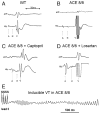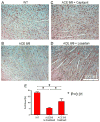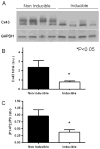Inhibition of renin-angiotensin system (RAS) reduces ventricular tachycardia risk by altering connexin43
- PMID: 21553032
- PMCID: PMC3156477
- DOI: 10.1007/s00109-011-0761-3
Inhibition of renin-angiotensin system (RAS) reduces ventricular tachycardia risk by altering connexin43
Abstract
Renin-angiotensin system (RAS) activation is associated with arrhythmias. We investigated the effects of RAS inhibition in cardiac-specific angiotensin-converting enzyme (ACE) overexpression (ACE 8/8) mice, which exhibit proclivity to ventricular tachycardia (VT) and sudden death because of reduced connexin43 (Cx43). ACE 8/8 mice were treated with an ACE inhibitor (captopril) or an angiotensin receptor type-1 blocker (losartan). Subsequently, electrophysiological studies were performed, and the hearts were extracted for Cx43 quantification using immunoblotting, immunohistochemistry, fluorescent dye spread method, and sodium current quantification using whole cell patch clamping. VT was induced in 12.5% of captopril-treated ACE 8/8 and in 28.6% of losartan-treated mice compared to 87.5% of untreated mice (P < 0.01). Losartan and captopril treatment increased total Cx43 2.4-fold (P = 0.01) and the Cx43 phosphorylation ratio 2.3-fold (P = 0.005). Treatment was associated with a recovery of gap junctional conductance. Survival in treated mice improved to 0.78 at 10 weeks (95% confidence interval 0.64 to 0.92), compared to the expected survival of less than 0.50. In a model of RAS activation, arrhythmic risk was correlated with reduced Cx43 amount and phosphorylation. RAS inhibition resulted in increased total and phosphorylated Cx43, decreased VT inducibility, and improved survival.
Conflict of interest statement
Figures






Similar articles
-
Inhibition of c-Src tyrosine kinase prevents angiotensin II-mediated connexin-43 remodeling and sudden cardiac death.J Am Coll Cardiol. 2011 Nov 22;58(22):2332-9. doi: 10.1016/j.jacc.2011.07.048. J Am Coll Cardiol. 2011. PMID: 22093512 Free PMC article.
-
Cardiac-restricted angiotensin-converting enzyme overexpression causes conduction defects and connexin dysregulation.Am J Physiol Heart Circ Physiol. 2007 Jul;293(1):H182-92. doi: 10.1152/ajpheart.00684.2006. Epub 2007 Mar 2. Am J Physiol Heart Circ Physiol. 2007. PMID: 17337599 Free PMC article.
-
Renin angiotensin system blockade ameliorates lead nephropathy.Biochem Biophys Res Commun. 2013 Aug 23;438(2):359-63. doi: 10.1016/j.bbrc.2013.07.076. Epub 2013 Jul 26. Biochem Biophys Res Commun. 2013. PMID: 23896603
-
Exploring the Evidence Implicating the Renin-Angiotensin System (RAS) in the Physiopathology of Mood Disorders.Protein Pept Lett. 2020;27(6):449-455. doi: 10.2174/0929866527666191223144000. Protein Pept Lett. 2020. PMID: 31868144 Review.
-
Effects of renin-angiotensin system inhibition on end-organ protection: can we do better?Clin Ther. 2007 Sep;29(9):1803-24. doi: 10.1016/j.clinthera.2007.09.019. Clin Ther. 2007. PMID: 18035185 Review.
Cited by
-
Connexin 43 is an emerging therapeutic target in ischemia/reperfusion injury, cardioprotection and neuroprotection.Pharmacol Ther. 2015 Sep;153:90-106. doi: 10.1016/j.pharmthera.2015.06.005. Epub 2015 Jun 11. Pharmacol Ther. 2015. PMID: 26073311 Free PMC article. Review.
-
Atrial Electrical Remodeling in Mice With Cardiac-Specific Overexpression of Angiotensin II Type 1 Receptor.J Am Heart Assoc. 2022 Apr 19;11(8):e023974. doi: 10.1161/JAHA.121.023974. Epub 2022 Apr 18. J Am Heart Assoc. 2022. PMID: 35435021 Free PMC article.
-
Angiotensin receptor antagonists to prevent sudden death in heart failure: does the dose matter?ISRN Cardiol. 2014 Feb 6;2014:652421. doi: 10.1155/2014/652421. eCollection 2014. ISRN Cardiol. 2014. PMID: 24653841 Free PMC article. Review.
-
Connecting the renin-angiotensin-aldosterone system with sudden death.J Mol Med (Berl). 2011 Jul;89(7):631-3. doi: 10.1007/s00109-011-0772-0. J Mol Med (Berl). 2011. PMID: 21607541 No abstract available.
-
The role of iron overload and ferroptosis in arrhythmia pathogenesis.Int J Cardiol Heart Vasc. 2024 Apr 26;52:101414. doi: 10.1016/j.ijcha.2024.101414. eCollection 2024 Jun. Int J Cardiol Heart Vasc. 2024. PMID: 38694269 Free PMC article. Review.
References
-
- Swedberg K, Kjekshus J. Effects of enalapril on mortality in severe congestive heart failure: results of the Cooperative North Scandinavian Enalapril Survival Study (CONSENSUS) Am J Cardiol. 1988;62:60A–66A. - PubMed
-
- Yusuf S, Sleight P, Pogue J, Bosch J, Davies R, Dagenais G. Effects of an angiotensin-converting-enzyme inhibitor, ramipril, on cardiovascular events in high-risk patients the heart outcomes prevention evaluation study investigators. N Engl J Med. 2000;342:145–153. - PubMed
-
- Pitt B, Zannad F, Remme WJ, Cody R, Castaigne A, Perez A, Palensky J, Wittes J. The effect of spironolactone on morbidity and mortality in patients with severe heart failure randomized aldactone evaluation study investigators. N Engl J Med. 1999;341:709–717. - PubMed
-
- Pitt B, Remme W, Zannad F, Neaton J, Martinez F, Roniker B, Bittman R, Hurley S, Kleiman J, Gatlin M. Eplerenone, a selective aldosterone blocker, in patients with left ventricular dysfunction after myocardial infarction. N Engl J Med. 2003;348:1309–1321. - PubMed
Publication types
MeSH terms
Substances
Grants and funding
LinkOut - more resources
Full Text Sources
Other Literature Sources
Miscellaneous

